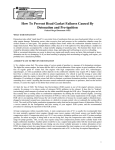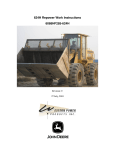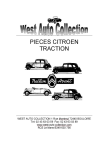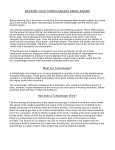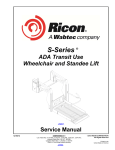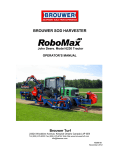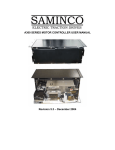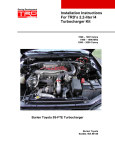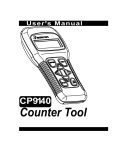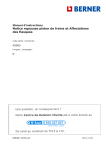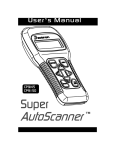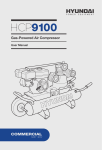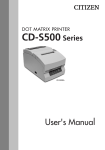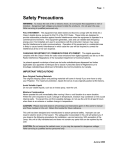Download Turbo Technics Capri
Transcript
2008 2 This kit is identical to the famous kits we produced in the 80's and 90's, which, when fitted to the new Capri's would make 200bhp. Producing power at high speed is relatively easy, but the aim of the development programme was to build an engine which would also produce a high level of torque from very low speed. The key to achieving this is the exhaust manifold and Turbo Technics design expertise has produced a technically advanced pulse separation configuration, using a single turbo. In conjunction with the carefully matched Garrett T3 turbocharger, excellent low speed response is achieved, with minimal turbo lag. The resulting engine not only gives exhilarating performance, but does so in a totally fuss-free manner, with no perceptible transition to "boost" conditions. Economy is virtually unaffected, and an effective intercooler in conjunction with a carefully integrated system ensures a very high degree of reliability, for which Turbo Technics have established a trend-setting reputation. The kit uses the standard compression ratio and runs with standard transmission and consists of a T3 turbocharger, manifold, intercooler, vacuum capsule, fuel enrichment air cone block, oil feed and return pipes, cross pipe and a down pipe from the turbo as well as all the pipe work and clips to plumb everything in. The only part not included from the original kit is the complete exhaust system - see figure 13 in drawings. The Turbo system can be fitted in a few days by any competent DIY-er and does not need to be carried out by specialists. However, it is important that the engine is in good mechanical condition before the kit is installed, especially if it has covered highmileage. Engine Power Output. Maximum power = 200BHP (149Kw) @ 5,500rpm Maximum torque = 247 Lbf-Ft (320Nm) @ 3,800rpm Typical Performance Figures Capri 0-60 MPH 0-100 MPH Max speed 200BHP 6.5 seconds 14.8 seconds 143 MPH on the standard final drive The cost of the kit is £2500 + VAT. Your order will be taken with a 20% deposit. 3 CAPRI 2.8i TURBO Service Bulletin INTRODUCTION The special edition Capri 2.8i Turbo follows the same turbo system layout as employed previously by Turbo Technics on this model, and is similar to that used on the XR4i, XR4x4 and Granada models. The turbo system is based on the use of a single Garrett AiResearch T3 turbocharger mounted on the left side, with an air/air intercooler cooling the charge air prior to entering the engine. The basic engine remains standard. Harder suspension location bushes are employed at key points, together with upgraded front brake pads. 4-pot front callipers and ventilated discs are available as an optional extra. MODELS COVERED Turbo system types: F9 - Turbo Technics 200 BHP (service details identical to f26) ROUTINE SERVICING Service intervals - 6,000 miles or 6 months. 12.000 mile (or 12 month) service -as Ford requirements, plus blow off the exterior of the intercooler with an air line. Check all pipes for tightness. 6.000 mile (or 6 months) service -as Ford requirements, plus change spark plugs. SPARK PLUG TYPE NGK - BCP6ES, gap 0.75mm. IGNITION TIMING 12° B.T.D.C @ 900 rpm -vacuum disconnected. NOTE: On no account should the engine be run under load with the vacuum pipe disconnected. IDLE CO SETTING 1- 1.5% with the engine thoroughly warmed. Idle speed 900 rpm ENGINE OIL The use of synthetic or semi-synthetic oil is recommended for turbocharged engines Turbo Technics approves the use of Shell Gemini in the Capri Turbo. FURTHER SERVICE NOTES ENGINE F9. The engine is unmodified except for the distributor advance capsule. TURBOCHARGER No servicing is required for the turbocharger. In the event of a turbocharger failure, it must be removed complete and replaced by a factory reconditioned unit. Only the pressure-controlling wastegate actuator can be replaced as a service item... Do not attempt to dismantle the turbocharger as this will almost certainly cause damage. BOOST PRESSURE CHECK Connect a suitable pressure gauge to the Inlet plenum at the multi-connection offtake. Run the vehicle on the road in 3rd gear at 3,000 rev/min using full throttle. Hold steady speed for a few seconds by braking with the left foot, and read the boost pressure. Repeat at 1,750 rev./min. Pressures should be: 1,750 rpm: 3,000 rpm: F9 0.25 bars (3.6 lbf/in2) min 0.40/0.45 bars (5.8/6.5 lbf/in2) 4 ACTUATOR REPLACEMENT Check the actuator for free movement and diaphragm integrity by pressurising up to but not beyond the working pressure. There should be no leakage. To replace an actuator, fit the new unit and adjust the screwed rod-end so that it must be pulled out approximately 2mm to fit over the pin on the arm. Road test, as described above, and adjust the pressure as necessary; shorten the rod (1 turn at a time maximum) to increase boost, and lengthen to reduce. Lock the nut, and refit the E-clip. FUEL SYSTEM The fuel system is standard, except that a profile block is fitted to the air metering cone. However, the system is balanced to give matched flows from each injector. Injectors must always be kept in their respective positions, and if any component of the system is changed a flow check must be made. With the air flap at full lift, the flow from each injector must be within 200/220 c.c./min. IGNITION SYSTEM The ignition system is standard except: 1. A vacuum advance/pressure retard capsule is fitted to the distributor. Retard should be 8/10° C.A. at 0.40 bars pressure at all speeds. Free movement of the base-plate should be checked. 2. An over-boost pressure switch is fitted in the inlet plenum to interrupt the ignition feed in the event of turbocharger control system failure. 3. Silicone ignition leads are fitted. EXHAUST SYSTEM The standard exhaust system is retained for the main run, including the two main expansion boxes, cut 520mm in front of these boxes, and a 2-section front pipe and Y-piece connects. FAULT DIAGNOSIS - SYMPTOMS AND POSSIBLE CAUSE LOW POWER 1.0 Check vehicle servicing: Particularly check spark plugs, filters, valve clearances 2.0 Check boost pressure: 2.1 Low pressure at 1,750 rpm: air leak exhaust leak intake blockage throttle not opening weak mixture on load damaged turbo turbo wastegate not closing 2.2 Correct pressure at 1,750 rpm, but low pressure at 3,000 rpm: wastegate actuator incorrectly set 3.0 Check ignition timing: With vacuum disconnected: Idle timing should be 12° B.T.D.C Timing at 3,000 rpm should be 17/21° B.T.D.C. 4.0 Check fuel/air mixture: Check injector flows as above Check full-throttle CO on a rolling road -should be 3 - 5% between 3,000 rpm and 5,000 rpm 5.0 Check engine condition: Normal condition check as described in the Ford service manual. 5 MISFIRING 1.0 Check vehicle servicing: Check spark plugs - type and condition Check H.T leads -continuity and insulation Check H.T firing voltages 2.0 Check turbo boost at 3,000 rpm: Over-boosting will cause intermittent cutting of the ignition supply. DETONATION 1.0 Check fuel: 96 RON octane (4 star) minimum - NO LUBRICATING ADDITIVES 2.0 Check ignition timing: With vacuum disconnected: Idle timing should be 12° B.T.D.C. Timing at 3,000 rpm should be 17/21° B.T.D.C. Check for smooth advance action 3.0 Check ignition timing retard: 0.40 bars pressure on the distributor capsule should give 8/10° C.A. retard, Check for smooth action 4.0 Check for over-boosting: Boost pressure at 3,000 rpm too high incorrect actuator setting leaking actuator pressure pipe perforated actuator diaphragm sticking wastegate 5.0 Incorrect valve function: Check valve seat condition Check valve clearances. Check cam timing 6.0 Oil pull-over: Check compressor inlet and rocker cover vents for excessive oil flow HIGH FUEL CONSUMPTION 1.0 Check part throttle CO: CO at high idle (2,000- 3,000 rpm) should drop to below 0.50%. This with the vehicle stationary. On rolling road test, steady CO readings should be less than 1% at off-boost conditions. 2.0 Check ignition timing: Particularly check the function of the vacuum advance capsule. 3.0 Check engine conditions: HIGH OIL CONSUMPTION 1.0 Oil smoke on full power: excessive ring wear damaged pistons damaged bores 2.0 Oil smoke on over-run: poor valve guide condition damaged stem seals. 3.0 Oil smoke at idle: damaged turbo seals 4.0 engine oil leaks: damaged pistons/bores blocked breather. 6 Parts List Item 1 2 3 4 5 6 7 8 9 10 11 12 13 14 15 16 17 18 19 20 21 22 23 24 25 26 27 28 29 30 31 32 33 34 35 36 37 38 39 40 41 42 43 44 45 46 47 47 48 49 50 51 52 Part No TT076 1892-50 1250-51 S5025-1 S5025-1 BM1030S S5006 NM10SP 1286-1 1286-2 1271 1272 1043-12 NM08PH 6063 1756 1763 SGL 50-70 SGL 50-70 1601-100 1764 6056 SGL 50-70 1261 6055 SGL 60-80 1191-1 1579-360 6028 1290 1221-3 S5024 PWM10C S5034-1 6047 DW002 S5022-2 1277-0 1905 1276 6010 SGL 20-32 BM0825 SWM08 1906-2 6060 1297 DHB 224 DHB 220 DHB 216 DHB 316 1366 Description Turbocharger assembly Compressor inlet assembly Exhaust manifold assembly Stud Stud Bolt Nut Nut Exhaust cross-pipe - left bank Exhaust cross-pipe - right bank Clamp flange - Ford original part Exhaust front pipe Exhaust centre pipe – NOT SUPPLIED IN KIT Exhaust clamp flange Locking nut - high temperature U-clamp Intercooler assembly Air pipe - turbo to front panel Hose clip Hose clip Bulkhead connection Pipe - front panel to intercooler Convoluted hose connection Hose clip Pipe - air inlet Elbow – rubber Hose clip Pipe - air meter outlet Convoluted hose Over-boost switch Heat shield - plug lead Oil feed pipe Banjo adapter Washer – copper Banjo Adapter Washer – Dowty Banjo bolt Oil drain pipe Oil drain connection Oil drain stub Hose – silicon Hose clip Bolt Washer Breather diverter valve One way valve Restrictor Ignition lead Ignition lead Ignition lead Coil lead Vacuum capsule service as pair 7 Brakes - Standard Calliper 6244 Brake pads Mintex Brakes - 4 Pot Calliper 6243 6209 6206 6207 6208 1907 Brake pad Brake disc Calliper assembly – left side Calliper assembly – right side Spacer washer (2 per side) Brake pipe 8 9 Breather System Diagram Breather System operation On Boost Valve 6060 closes. Engine breathes via valve A053 to air metering unit and hence to engine. On Over-Run Valve A053 closes. Engine breathes via by pass, through valve 6060 to plenum chamber. Note: 3/8" hose from plenum chamber to valve 6060 must be secured with clips. Valve A053 is tie-wrapped to the brake pipes on the bulkhead. Detailed below are the Miofiltre Valve and Fuel Enrichment (Profile) Block 10 CAPRI V6 2.8i TURBO The exclusive performance system developed by Turbo Technics From the same stable as the well-renowned XR3i, the V6 turbo system employs the same design principles, and engineering expertise to produce a superbly balanced performance. Producing power at high speed is relatively easy, but the aim of the development programme was to build an engine which would also produce a high level of torque from very low speed. The key to achieving this is the exhaust manifold, and Turbo Technics design expertise has produced a technically advanced pulse separation configuration, using a single turbo. In conjunction with the carefully matched Garrett T3 turbocharger, excellent low speed response is achieved, with minimum "turbo lag". The resulting engine not only gives an already good vehicle exhilarating performance, but does so in a totally fuss-free manner, with no perceptible transition to "boost" conditions. Economy is virtually unaffected, and intercooling coupled with a carefully integrated system ensures a very high degree of reliability, for which Turbo Technics have established a trendsetting reputation. The 200 bhp turbo engine uses standard compression ratio, and runs with standard transmission. The turbo system can be fitted in a few days at either Turbo Technics Northampton or Aldershot facilities, and whilst careful servicing is required, this does not need to be carried out by specialists. Warranty for a period of 12 months an all Turbo Technics components is included. Engine Power Output Typical Performance Figures Maximum Power 0 - 60 mph ~ 6.5 seconds 200 bhp (149Kw) @ 5,500 rpm 0 - 100 mph ~ 14.8 seconds Maximum Torque Maximum Speed ~ 143 mph 247lbs-ft (320Nm) @ 3,800 rpm Technical Specifications Turbocharger • Turbo Technics assembled Garrett T3 with integral wastegate pressure control. The turbo is mounted on the nearside with a link pipe carrying gas across from the off-side manifold. Exhaust Manifold • Multi-branch manifold designed for pulse separation, cast in high nickel iron. Air Supply • Air supply is through the standard filter to the compressor, then cooled by a front mounted intercooler before passing to the standard inlet manifold. Fuel System • The standard injection system is retained with minor modification. 11 Ignition • The standard high energy electronic ignition is retained, with a modified characteristic incorporating a vacuum advance / pressure retard capsule. Wide heat-range spark plugs are employed, with silicone high tension leads. Lubrication • An oil supply is taken from the main engine feed via Aeroquip pipe to the turbo, returning to the sump. Cooling • The standard radiator is retained. Service • Apart from different spark plugs and ignition timing, servicing is unaltered. 12












